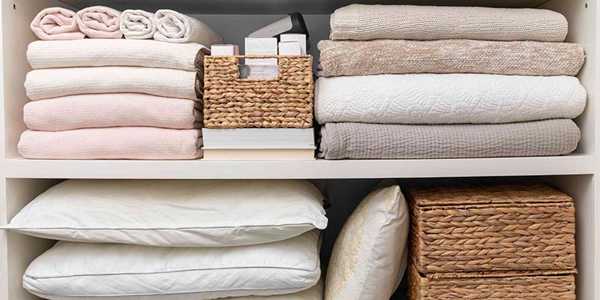The Ultimate Linen Closet Organization System That Lasts
The absolute best way to organize your linen closet is to follow a simple, three-step framework: Declutter ruthlessly, categorize everything logically, and contain items smartly. This method transforms your closet from a chaotic avalanche-in-waiting into a streamlined, functional, and even beautiful space. If you're struggling with how to organize towels and sheets or are looking for small linen closet ideas, you've come to the right place.
For the past 20 years, I've helped people conquer clutter, and the linen closet is often a source of hidden stress. It doesn't have to be. In this comprehensive guide, we'll walk through every single step, from deciding what to keep to mastering the art of folding a fitted sheet. We'll cover the best storage containers, tackle tricky closet shapes, and establish a system that's easy to maintain. Let's get this done.

Getting Started: The 3-Step Foundation for a Perfect Linen Closet
Before you buy a single bin or basket, we need to lay the groundwork. Rushing to buy containers for clutter is the number one mistake I see. A truly organized space starts with intention, not products. These three foundational steps are non-negotiable for long-term success.
Step 1: The Great Purge - Decluttering Like a Pro
First, take everything out. Yes, everything. Pile it all on your bed or the floor so you can see exactly what you're dealing with. This is the only way to get an honest inventory. As you handle each item—every towel, sheet set, and pillowcase—ask yourself a few tough questions:
- Is it stained, ripped, or worn out?
- Do I (or does anyone in my house) actually like using this?
- Is it a "just in case" item I haven't touched in over a year?
- Do I have a matching set for this, or is it an orphan pillowcase?
Be honest. That threadbare towel from college? It's time. The pilled flannel sheets you never use because they make you too hot? Gone. Create three piles: Keep, Donate/Recycle, and Trash. Many animal shelters are thrilled to accept old towels and blankets for bedding, so check locally before you toss them.
Step 2: Smart Categories - Grouping for Easy Access
With only the "Keep" pile left, it's time to sort. This isn't just about putting like with like; it's about creating a system that mirrors how you live. Your categories will become your "zones" within the closet. Start with broad categories and then get more specific.
Typical linen closet categories include:
- Bedding by Size/Room: King, Queen, Twin, Guest Room, etc.
- Towels by Type/Room: Bath Towels, Hand Towels, Washcloths, Guest Towels, Beach/Pool Towels.
- Bulky Items: Comforters, Duvets, Quilts, Extra Pillows.
- Table Linens: Tablecloths, Placemats, Napkins.
- Backstock: Extra toiletries, toilet paper, tissues. (If your closet serves double duty).
The goal is to be able to grab what you need without disturbing anything else. If your kids' bedding is always in the wash, give it a prime, easy-to-reach spot. The guest room sheets you use twice a year can go on the top shelf.
Step 3: Contain & Conquer - Choosing the Right Storage
Now, and only now, can you think about containers. The right containers aren't just for looks; they create defined boundaries for your categories. They stop neat piles from slumping over and prevent items from getting lost in the back of a deep shelf. Here's a breakdown of the best options:
| Container Type | Best For | Pros | Cons |
| Woven Baskets (Hyacinth, Seagrass) | Towels, throw blankets, toilet paper rolls | Aesthetically pleasing, breathable, sturdy | Can be bulky, may snag delicate fabrics |
| Clear Plastic Bins | Sheet sets, toiletries, cleaning supplies | Easy to see contents, stackable, protect from dust | Can look clinical, less breathable |
| Fabric Bins/Cubes | Smaller items, washcloths, table napkins | Lightweight, collapsible, variety of colors/sizes | Can become misshapen if overstuffed |
| Wire Baskets | Rolled towels, backstock toiletries | Good visibility, modern look, allows airflow | Small items can fall through, can leave marks on shelves |
Measure your shelves before you buy! There's nothing more frustrating than returning from a shopping trip to find your beautiful new baskets are half an inch too wide. Plan your layout, assign a container type to each category, and then purchase what you need.
Mastering the Details: Folding Techniques and Storage Hacks
An organized closet isn't just about what you keep, but how you keep it. Proper folding and clever storage tricks are what elevate a tidy closet to a professional-level system. These are the techniques I've taught hundreds of clients, and they work every time.

The Ultimate Guide to Folding a Fitted Sheet (Finally!)
Let's end the madness. No more balled-up monsters. Follow these steps precisely, and you'll have a crisp, flat rectangle every time.
- Step 1 (Inside-Out Corners): Stand holding the sheet lengthwise. Place your hands inside the two top corners, with the elastic edge facing you. The sheet should be inside-out.
- Step 2 (Corner to Corner): Bring your right hand to your left hand. Flip the right corner over the left corner, so they are now nested together. Adjust so the seams line up neatly.
- Step 3 (Bring Up the Bottom): Run your hand down the hanging edge to find the next corner (it will be the one directly below the corners you are holding). Pick it up and tuck it into the two corners already on your left hand.
- Step 4 (The Final Corner): Find the last remaining corner and tuck it in with the other three. All four elastic corners should now be nested together in your left hand, forming a rough "L" or rectangle shape.
- Step 5 (The Fold): Lay the sheet on a flat surface. You'll see it has a straight edge and a curved, elastic edge. Fold the elastic edge inward to create a neat rectangle. From there, fold it into thirds, like a letter, to create your final, perfect square.
Practice makes perfect. After a few tries, you'll be able to do this in under 30 seconds. It's a game-changer for saving space and reducing wrinkles.
How to Fold Towels for a Spa-Like Feel
You have two great options here: file folding for shelf efficiency or rolling for a spa vibe and use in deep baskets. File Folding (Best for Stacking):
This creates a tidy packet that can be "filed" on the shelf like a book. You can see every towel at a glance and pull one out without toppling the whole stack.
Rolling (Best for Baskets):
Rolled towels look fantastic stored upright in a deep basket and can sometimes fit into awkward spaces more easily than folded ones.
Storing Bulky Items: Comforters, Duvets, and Pillows
These are the space hogs of the linen closet. The best place for them is the top shelf or the floor, as they are used less frequently. Vacuum-seal bags are a popular choice, and they can be fantastic for long-term or seasonal storage. They dramatically reduce bulk, especially for puffy comforters and pillows.
However, a word of caution: Be careful with natural fibers like down or wool. Leaving them compressed for too long can crush the fibers and reduce their loft and insulating properties. For items you use more regularly, or for delicate natural fills, a large, zippered fabric bag or a simple strap tied around the rolled item is a better choice. It keeps things contained without extreme compression.
The Sheet Set Secret: A Simple Trick to Never Lose a Pillowcase Again
This is my favorite simple hack that clients adore. Once you've neatly folded your flat sheet and your (now perfect) fitted sheet, stack them together. Then, take one of the corresponding pillowcases and tuck the entire folded set inside it. This creates a neat, self-contained packet for each sheet set. No more hunting for a matching pillowcase! You can stack these packets beautifully on a shelf, and you'll always grab a complete set in one go. It's pure organizational bliss.

Solving Common Problems: Small, Deep, and Awkward Closets
Not all linen closets are created equal. Many homes, especially older ones, have closets that are frustratingly small, incredibly deep, or just plain weird. Don't despair. Strategy can overcome poor design.
Organizing a Small or Narrow Linen Closet: Maximizing Vertical Space
When you can't go wide, you must go high. The key to a tiny closet is using every inch of vertical space.
Taming the Deep Linen Closet: Making the Back Accessible
Deep closets feel like a blessing until you realize you can't reach anything in the back. The goal here is to make the back of the closet as accessible as the front.
What If I Don't Have a Linen Closet at All?
Many modern apartments or minimalist homes lack a dedicated linen closet. It's time to get creative.
Keeping It Fresh: Maintenance and Scent
You've done the hard work. Your closet is a masterpiece. Now, how do you keep it that way? A little maintenance and a touch of sensory pleasure will make your system last and bring you joy every time you open the door.
How to Make Your Linen Closet (and Linens) Smell Amazing
A well-organized closet that smells fresh is a true delight. Stale air and musty smells can plague linen closets. Here are some safe and effective ways to keep things fragrant:
| Scenting Method | How It Works | Pro Tip |
| Cedar Blocks/Balls | Naturally repel moths and absorb moisture and odors. | Sand them lightly once a year to refresh the scent. |
| Lavender Sachets | Provide a gentle, calming floral scent. | Tuck them between stacks of sheets or inside baskets. |
| Essential Oil on a Cotton Ball | A few drops of your favorite oil (like eucalyptus or sandalwood) on a cotton ball placed in a small dish. | Refresh every couple of weeks. Avoid direct contact with fabrics to prevent oil stains. |
| Unwrapped Scented Soap | An old-fashioned trick that works wonders. A bar of strongly scented soap will gently perfume the entire space. | Choose a scent you love and just place the bar on a shelf. |
Creating a System That Sticks: The Weekly and Monthly Reset
The key to permanent organization is building the maintenance into your routine. It takes just a few minutes.
- The Weekly Reset (2 Minutes): When you put away clean laundry, take an extra 30 seconds to fold it properly and put it back in its designated zone. Straighten any stacks that have gone crooked. That's it.
- The Monthly Tidy-Up (10 Minutes): Once a month, take a quick look. Are any categories overflowing? Is it time to purge a towel that's seen better days? Refold anything that's been shoved in during a rush. This quick check-in prevents the system from ever getting out of control again.
This isn't about being perfect; it's about being consistent. A little effort regularly prevents a massive overhaul project later.
Pro Tip: The Importance of Washing Linens Before Storage
This may seem obvious, but it's a crucial final point. Always, always wash and thoroughly dry your linens before putting them away for any length of time. Even minor amounts of skin oils, lotions, or moisture can lead to yellowing stains and musty smells over time. Putting away clean, dry linens is the first step to ensuring they come out fresh when you need them.
Conclusion
Organizing your linen closet is about so much more than just tidying up. It's about creating a system that saves you time, reduces stress, and makes your home feel more peaceful and under control. By following the core principles—Declutter, Categorize, and Contain—and using the pro techniques we've covered, you can build a functional and beautiful space that truly serves you and your family. Your future self, reaching for a perfectly folded, fresh-smelling towel, will thank you.
If this guide helped you conquer your closet, please consider sharing it with someone else who could use a little organizational inspiration!





